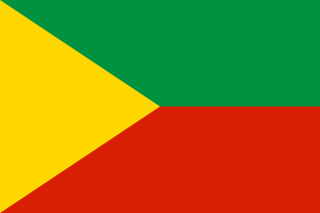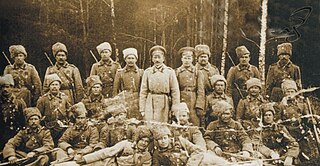
Amur Oblast is a federal subject of Russia, located on the banks of the Amur and Zeya Rivers in the Russian Far East. The administrative center of the oblast, the city of Blagoveshchensk, is one of the oldest settlements in the Russian Far East, founded in 1856. It is a traditional center of trade and gold mining. The territory is accessed by two railways: the Trans-Siberian Railway and the Baikal–Amur Mainline. As of the 2010 Census, the oblast's population was 830,103.

Chita Oblast was a federal subject of Russia in southeast Siberia, Russia. Its administrative center was the city of Chita. It had extensive international borders with China (998 km) and Mongolia (868 km) and internal borders with Irkutsk and Amur Oblasts, as well as with the republics of Buryatia and Yakutia. Its area was 431,500 square kilometers (166,600 sq mi). Population: 1,155,346 (2002 Census); 1,377,975 (1989 Census).

The Far Eastern Republic, sometimes called the Chita Republic, was a nominally independent state that existed from April 1920 to November 1922 in the easternmost part of the Russian Far East. Although theoretically independent, it largely came under the control of the Russian Soviet Federative Socialist Republic (RSFSR), which envisaged it as a buffer state between the RSFSR and the territories occupied by Japan during the Russian Civil War of 1917–1922. Its first president was Alexander Krasnoshchyokov.

Agin-Buryat Okrug, or Aga Buryatia, is an administrative division of Zabaykalsky Krai, Russia. It was a federal subject of Russia until it merged with Chita Oblast to form Zabaykalsky Krai on March 1, 2008. Prior to the merger, it was called Agin-Buryat Autonomous Okrug. Its administrative center is the urban-type settlement of Aginskoye. It is one of the two Buryat okrugs in Russia, the other one is Ust-Orda Buryat Okrug of Irkutsk Oblast.

Ravil Faritovich Geniatulin was the Governor of Zabaykalsky Krai, Russia, an office he held from 1 February 1996 to 2 March 2013.

This gallery of flags of federal subjects of Russia shows the flags of the 89 federal subjects of Russia.

Zabaykalsky Krai is a federal subject of Russia, located in the Russian Far East. Its administrative center is Chita. As of the 2010 Census, the population was 1,107,107.

Agin-Buryat Autonomous Okrug was a federal subject of the Russian Federation. On 1 March 2008, the region merged with Chita Oblast to form the new Zabaykalsky Krai. The territory of the former ABAO is now the Agin-Buryat Okrug of Zabaykalsky Krai, in which it has a special status.

The Russian route R297 or the Amur Highway is a federal highway in Russia, part of the Trans-Siberian Highway. With a length of 2,100 km (1,300 mi), it is the longest segment, from Chita to Khabarovsk, connecting the paved roads of Siberia with those of the Russian Far East. The construction of the road united the Russian federal highways into a single system stretching from Saint Petersburg to Vladivostok. Before completion of the road, the Russian Pacific coast was connected to the rest of the country only by airlines, the Trans-Siberian Railway, and the Baikal–Amur Mainline.

The flag of Zabaykalsky Krai, along with the coat of arms, is the official symbol of Zabaykalsky Krai, a federal subject of Russia.

The Trans-Baikal Railway is a subsidiary of the Russian Railways headquartered in Chita and serving Zabaykalsky Krai and Amur Oblast. The mainline was built between 1895 and 1905 as part of the Trans-Siberian Railway. It bordered the Circum-Baikal Railway on the west and the Chinese Eastern Railway on the east. The railway bore the name of Vyacheslav Molotov between 1936 and 1943. The Amur Railway became part of the network in 1959. As of 2009, the railway employs 46 741 people; its route length totals 3336,1 km.

Chitinsky District is an administrative district (raion), one of the thirty-one in Zabaykalsky Krai, Russia. It is located in the west of the krai, and borders with Karymsky District in the east, Duldurginsky District in the south, and with Khiloksky District in the west. The area of the district is 16,100 square kilometers (6,200 sq mi). Its administrative center is the city of Chita. Population : 64,642 (2010 Census); 62,221 ; 62,366 (1989 Census).
Buddhism in Buryatia—a regional form of Buddhism.

The Governor of Zabaykalsky Krai is the head of the executive branch of government in Zabaykalsky Krai.
The 168th Motor Rifle Brigade was a Russian Ground Forces motorized infantry brigade from 1994 to 1998. It was based in Borzya and traces its lineage to the 150th Motor Rifle Division, activated in 1973. The division became a training unit three years later and was converted into a district training center in 1988. In 1994, the training center became the 168th Motor Rifle Brigade.

The 36th Separate Guards Motor Rifle Brigade is an infantry brigade of the Russian Ground Forces, which traces its heritage to the creation of the 38th Guards Rifle Division from the 4th Airborne Corps during World War II. The division gained its honorific on 23 September 1943 for its part in the seizure of Lozovaya in Ukraine.

The Chita Operations were a series of military engagements fought in the Russian Civil War. On 10 April 1920, the army of the Far Eastern Republic (FER) launched the first operation, aiming at destroying the White Movement's Chita holdup in east Transbaikal which prevented it from connecting with its allies in Primorsky Krai. The first operation ended three days later, a second offensive likewise failed to achieve its final objectives. Fighting continued, however neither side could boast significant territorial gains. On 15 July, the FER signed the Gongota Agreement of 1920 with Japan, the latter's withdrawal from Transbaikal severely weakened the Whites. The FER army was restructured and reinforced by its new commander Genrich Eiche, while morale under Grigory Semyonov's White units plummeted. On 1 October, Eiche launched the final Chita operation, by the end of the month the area of the Chita holdup had been subjugated.
The 2006–07 Russian Cup was the 15th edition of the Russian football knockout tournament since the dissolution of Soviet Union. The competition started on 13 April 2006 and finished on 27 May 2007, with the final played at the Luzhniki Stadium in Moscow, where Lokomotiv Moscow beat FC Moscow 1–0 at extra time.
The 4th Rocket Division was a division of the Soviet and Russian Strategic Rocket Forces.














